Contemporary Employee Relations: An Analysis of JLC and Trade Unions
VerifiedAdded on 2023/04/17
|12
|2794
|152
Report
AI Summary
This report provides an in-depth analysis of contemporary employee relations in Ireland, focusing on the role of Joint Labor Committees (JLCs) and trade unions. It begins with an introduction to JLCs, their establishment under the Industrial Relations Act 1946, and their function in setting terms and conditions of employment. The report then examines the key differences between the 2012 Industrial Relations (Amendment) Act and the recommendations of the Duffy-Walsh report, including the powers of JLCs to set wage rates and the consideration of economic factors. It further discusses the trade union movement in Ireland, the Irish Congress of Trade Unions, and the deregulation of the labor market. The report also presents the findings of the Duffy-Walsh review, which assessed the impact of sectoral wages agreements on employee wages, and the impact of the JLCs on the labor market. The report concludes by referencing the recommendations made in the Duffy-Walsh report and provides a detailed overview of the trade union movement and the deregulation of the labor market.
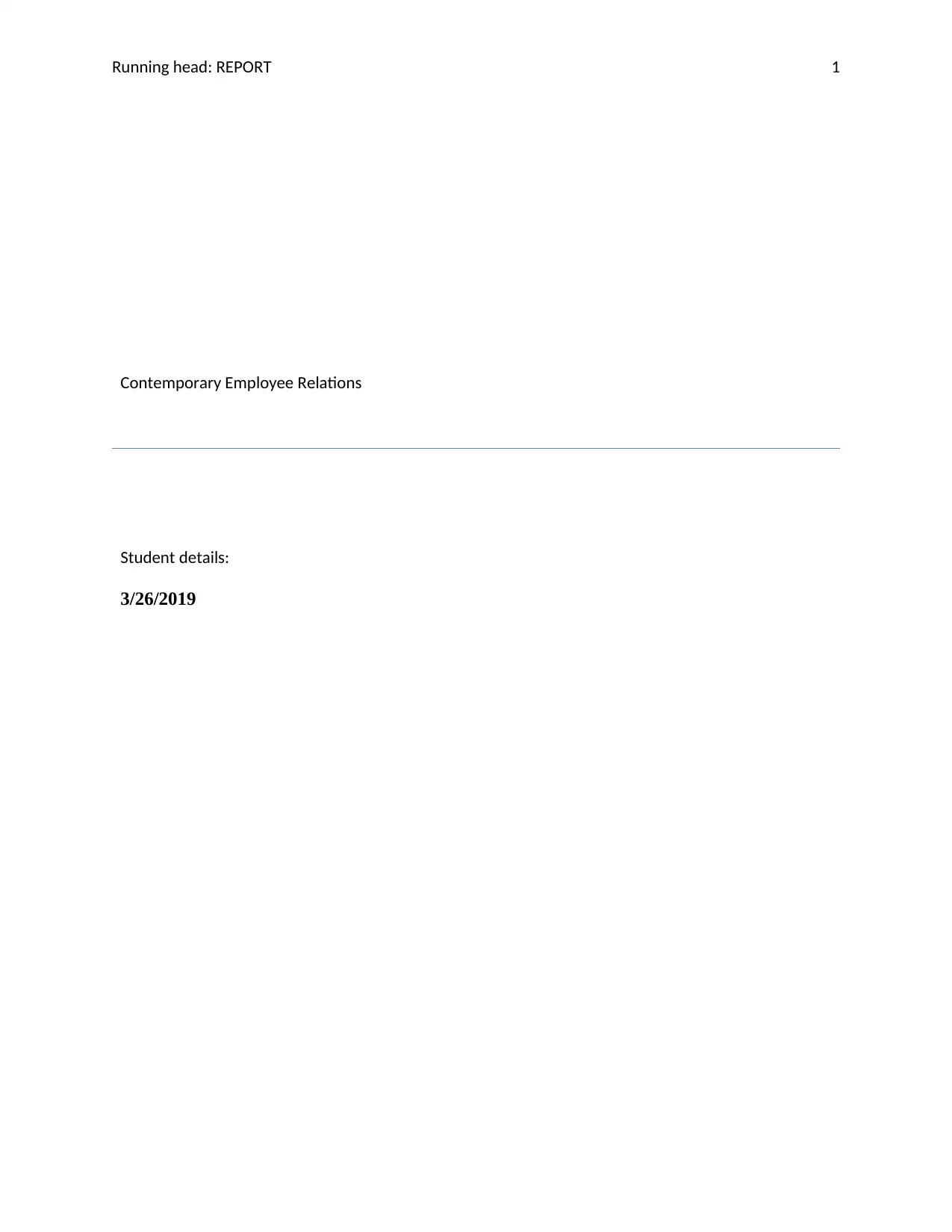
Running head: REPORT 1
Contemporary Employee Relations
Student details:
3/26/2019
Contemporary Employee Relations
Student details:
3/26/2019
Paraphrase This Document
Need a fresh take? Get an instant paraphrase of this document with our AI Paraphraser
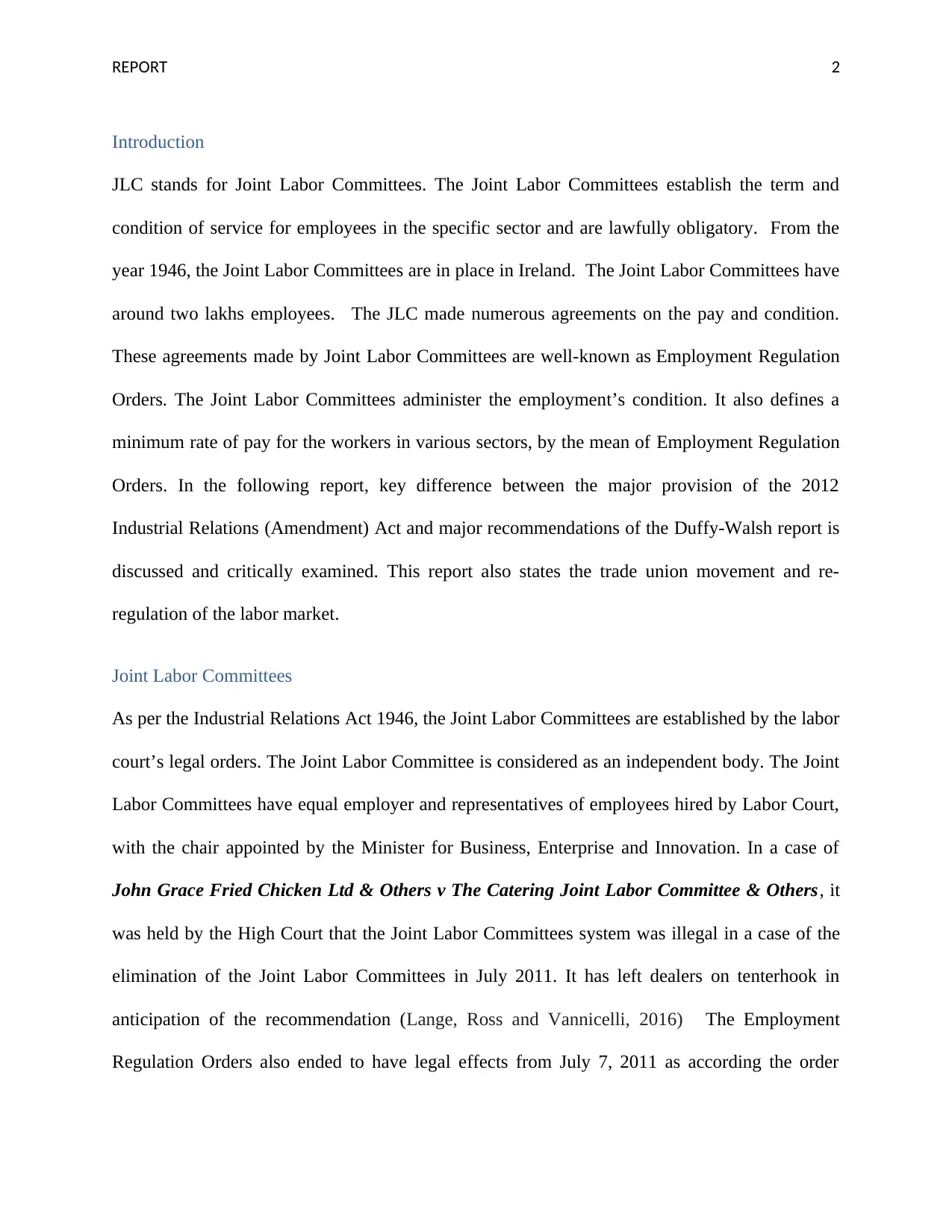
REPORT 2
Introduction
JLC stands for Joint Labor Committees. The Joint Labor Committees establish the term and
condition of service for employees in the specific sector and are lawfully obligatory. From the
year 1946, the Joint Labor Committees are in place in Ireland. The Joint Labor Committees have
around two lakhs employees. The JLC made numerous agreements on the pay and condition.
These agreements made by Joint Labor Committees are well-known as Employment Regulation
Orders. The Joint Labor Committees administer the employment’s condition. It also defines a
minimum rate of pay for the workers in various sectors, by the mean of Employment Regulation
Orders. In the following report, key difference between the major provision of the 2012
Industrial Relations (Amendment) Act and major recommendations of the Duffy-Walsh report is
discussed and critically examined. This report also states the trade union movement and re-
regulation of the labor market.
Joint Labor Committees
As per the Industrial Relations Act 1946, the Joint Labor Committees are established by the labor
court’s legal orders. The Joint Labor Committee is considered as an independent body. The Joint
Labor Committees have equal employer and representatives of employees hired by Labor Court,
with the chair appointed by the Minister for Business, Enterprise and Innovation. In a case of
John Grace Fried Chicken Ltd & Others v The Catering Joint Labor Committee & Others, it
was held by the High Court that the Joint Labor Committees system was illegal in a case of the
elimination of the Joint Labor Committees in July 2011. It has left dealers on tenterhook in
anticipation of the recommendation (Lange, Ross and Vannicelli, 2016) The Employment
Regulation Orders also ended to have legal effects from July 7, 2011 as according the order
Introduction
JLC stands for Joint Labor Committees. The Joint Labor Committees establish the term and
condition of service for employees in the specific sector and are lawfully obligatory. From the
year 1946, the Joint Labor Committees are in place in Ireland. The Joint Labor Committees have
around two lakhs employees. The JLC made numerous agreements on the pay and condition.
These agreements made by Joint Labor Committees are well-known as Employment Regulation
Orders. The Joint Labor Committees administer the employment’s condition. It also defines a
minimum rate of pay for the workers in various sectors, by the mean of Employment Regulation
Orders. In the following report, key difference between the major provision of the 2012
Industrial Relations (Amendment) Act and major recommendations of the Duffy-Walsh report is
discussed and critically examined. This report also states the trade union movement and re-
regulation of the labor market.
Joint Labor Committees
As per the Industrial Relations Act 1946, the Joint Labor Committees are established by the labor
court’s legal orders. The Joint Labor Committee is considered as an independent body. The Joint
Labor Committees have equal employer and representatives of employees hired by Labor Court,
with the chair appointed by the Minister for Business, Enterprise and Innovation. In a case of
John Grace Fried Chicken Ltd & Others v The Catering Joint Labor Committee & Others, it
was held by the High Court that the Joint Labor Committees system was illegal in a case of the
elimination of the Joint Labor Committees in July 2011. It has left dealers on tenterhook in
anticipation of the recommendation (Lange, Ross and Vannicelli, 2016) The Employment
Regulation Orders also ended to have legal effects from July 7, 2011 as according the order
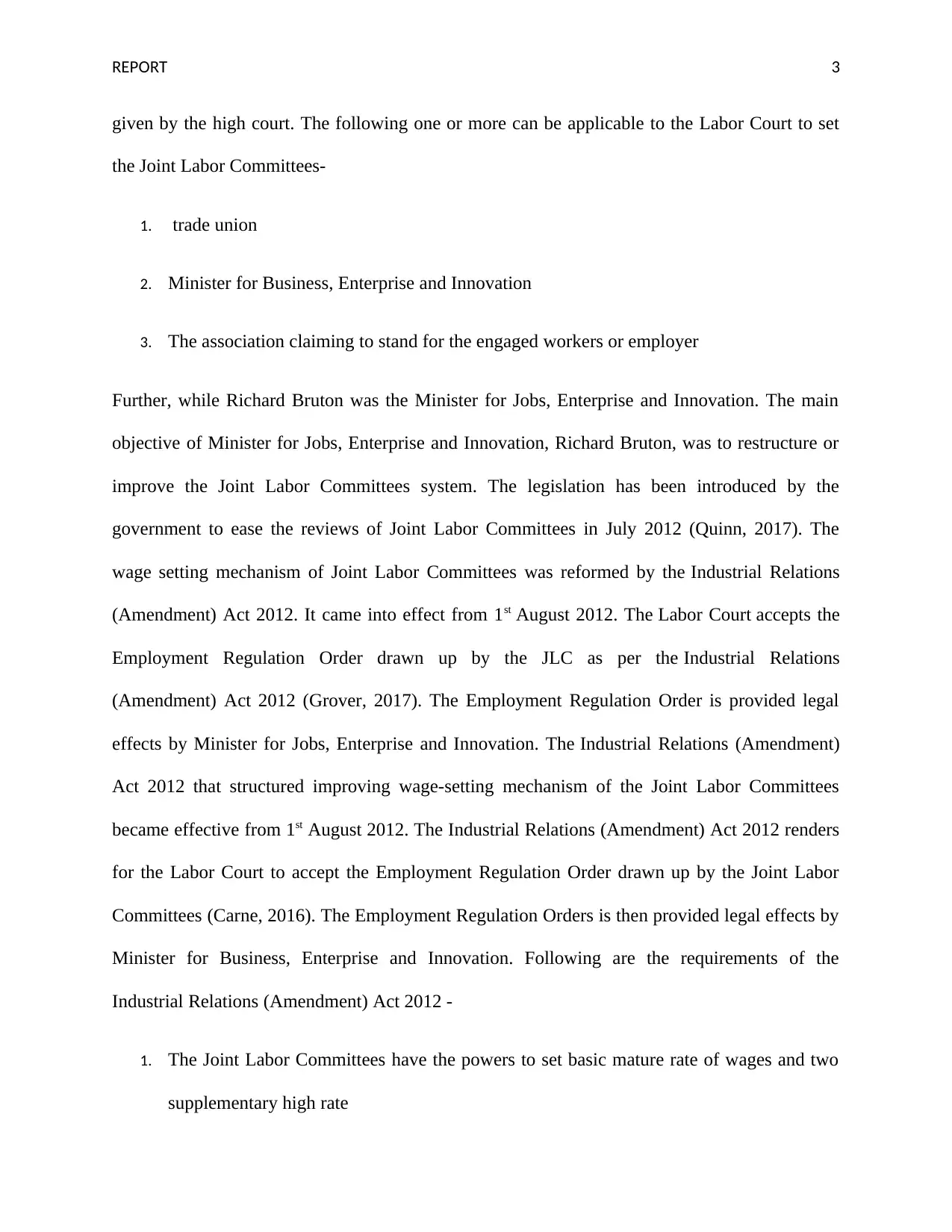
REPORT 3
given by the high court. The following one or more can be applicable to the Labor Court to set
the Joint Labor Committees-
1. trade union
2. Minister for Business, Enterprise and Innovation
3. The association claiming to stand for the engaged workers or employer
Further, while Richard Bruton was the Minister for Jobs, Enterprise and Innovation. The main
objective of Minister for Jobs, Enterprise and Innovation, Richard Bruton, was to restructure or
improve the Joint Labor Committees system. The legislation has been introduced by the
government to ease the reviews of Joint Labor Committees in July 2012 (Quinn, 2017). The
wage setting mechanism of Joint Labor Committees was reformed by the Industrial Relations
(Amendment) Act 2012. It came into effect from 1st August 2012. The Labor Court accepts the
Employment Regulation Order drawn up by the JLC as per the Industrial Relations
(Amendment) Act 2012 (Grover, 2017). The Employment Regulation Order is provided legal
effects by Minister for Jobs, Enterprise and Innovation. The Industrial Relations (Amendment)
Act 2012 that structured improving wage-setting mechanism of the Joint Labor Committees
became effective from 1st August 2012. The Industrial Relations (Amendment) Act 2012 renders
for the Labor Court to accept the Employment Regulation Order drawn up by the Joint Labor
Committees (Carne, 2016). The Employment Regulation Orders is then provided legal effects by
Minister for Business, Enterprise and Innovation. Following are the requirements of the
Industrial Relations (Amendment) Act 2012 -
1. The Joint Labor Committees have the powers to set basic mature rate of wages and two
supplementary high rate
given by the high court. The following one or more can be applicable to the Labor Court to set
the Joint Labor Committees-
1. trade union
2. Minister for Business, Enterprise and Innovation
3. The association claiming to stand for the engaged workers or employer
Further, while Richard Bruton was the Minister for Jobs, Enterprise and Innovation. The main
objective of Minister for Jobs, Enterprise and Innovation, Richard Bruton, was to restructure or
improve the Joint Labor Committees system. The legislation has been introduced by the
government to ease the reviews of Joint Labor Committees in July 2012 (Quinn, 2017). The
wage setting mechanism of Joint Labor Committees was reformed by the Industrial Relations
(Amendment) Act 2012. It came into effect from 1st August 2012. The Labor Court accepts the
Employment Regulation Order drawn up by the JLC as per the Industrial Relations
(Amendment) Act 2012 (Grover, 2017). The Employment Regulation Order is provided legal
effects by Minister for Jobs, Enterprise and Innovation. The Industrial Relations (Amendment)
Act 2012 that structured improving wage-setting mechanism of the Joint Labor Committees
became effective from 1st August 2012. The Industrial Relations (Amendment) Act 2012 renders
for the Labor Court to accept the Employment Regulation Order drawn up by the Joint Labor
Committees (Carne, 2016). The Employment Regulation Orders is then provided legal effects by
Minister for Business, Enterprise and Innovation. Following are the requirements of the
Industrial Relations (Amendment) Act 2012 -
1. The Joint Labor Committees have the powers to set basic mature rate of wages and two
supplementary high rate
⊘ This is a preview!⊘
Do you want full access?
Subscribe today to unlock all pages.

Trusted by 1+ million students worldwide
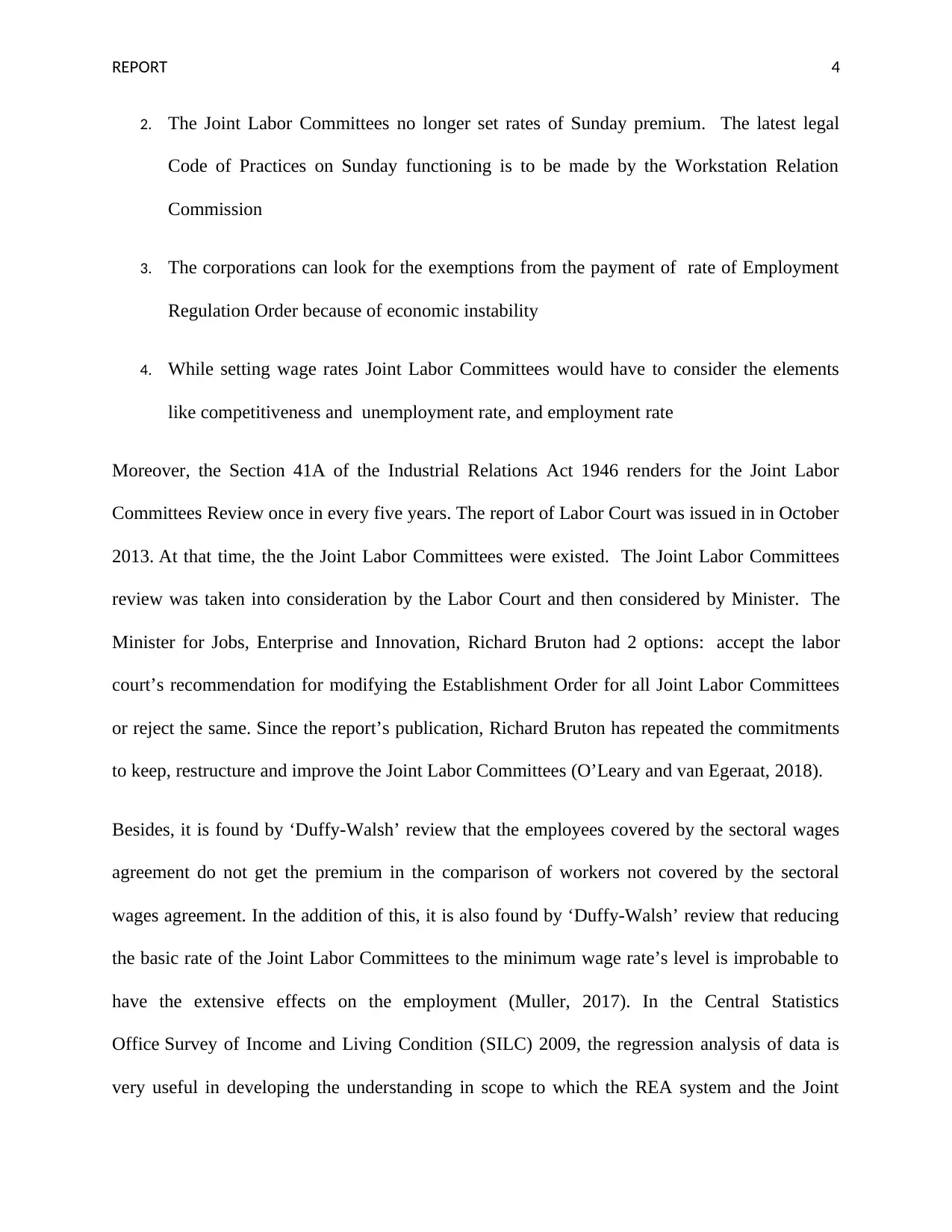
REPORT 4
2. The Joint Labor Committees no longer set rates of Sunday premium. The latest legal
Code of Practices on Sunday functioning is to be made by the Workstation Relation
Commission
3. The corporations can look for the exemptions from the payment of rate of Employment
Regulation Order because of economic instability
4. While setting wage rates Joint Labor Committees would have to consider the elements
like competitiveness and unemployment rate, and employment rate
Moreover, the Section 41A of the Industrial Relations Act 1946 renders for the Joint Labor
Committees Review once in every five years. The report of Labor Court was issued in in October
2013. At that time, the the Joint Labor Committees were existed. The Joint Labor Committees
review was taken into consideration by the Labor Court and then considered by Minister. The
Minister for Jobs, Enterprise and Innovation, Richard Bruton had 2 options: accept the labor
court’s recommendation for modifying the Establishment Order for all Joint Labor Committees
or reject the same. Since the report’s publication, Richard Bruton has repeated the commitments
to keep, restructure and improve the Joint Labor Committees (O’Leary and van Egeraat, 2018).
Besides, it is found by ‘Duffy-Walsh’ review that the employees covered by the sectoral wages
agreement do not get the premium in the comparison of workers not covered by the sectoral
wages agreement. In the addition of this, it is also found by ‘Duffy-Walsh’ review that reducing
the basic rate of the Joint Labor Committees to the minimum wage rate’s level is improbable to
have the extensive effects on the employment (Muller, 2017). In the Central Statistics
Office Survey of Income and Living Condition (SILC) 2009, the regression analysis of data is
very useful in developing the understanding in scope to which the REA system and the Joint
2. The Joint Labor Committees no longer set rates of Sunday premium. The latest legal
Code of Practices on Sunday functioning is to be made by the Workstation Relation
Commission
3. The corporations can look for the exemptions from the payment of rate of Employment
Regulation Order because of economic instability
4. While setting wage rates Joint Labor Committees would have to consider the elements
like competitiveness and unemployment rate, and employment rate
Moreover, the Section 41A of the Industrial Relations Act 1946 renders for the Joint Labor
Committees Review once in every five years. The report of Labor Court was issued in in October
2013. At that time, the the Joint Labor Committees were existed. The Joint Labor Committees
review was taken into consideration by the Labor Court and then considered by Minister. The
Minister for Jobs, Enterprise and Innovation, Richard Bruton had 2 options: accept the labor
court’s recommendation for modifying the Establishment Order for all Joint Labor Committees
or reject the same. Since the report’s publication, Richard Bruton has repeated the commitments
to keep, restructure and improve the Joint Labor Committees (O’Leary and van Egeraat, 2018).
Besides, it is found by ‘Duffy-Walsh’ review that the employees covered by the sectoral wages
agreement do not get the premium in the comparison of workers not covered by the sectoral
wages agreement. In the addition of this, it is also found by ‘Duffy-Walsh’ review that reducing
the basic rate of the Joint Labor Committees to the minimum wage rate’s level is improbable to
have the extensive effects on the employment (Muller, 2017). In the Central Statistics
Office Survey of Income and Living Condition (SILC) 2009, the regression analysis of data is
very useful in developing the understanding in scope to which the REA system and the Joint
Paraphrase This Document
Need a fresh take? Get an instant paraphrase of this document with our AI Paraphraser
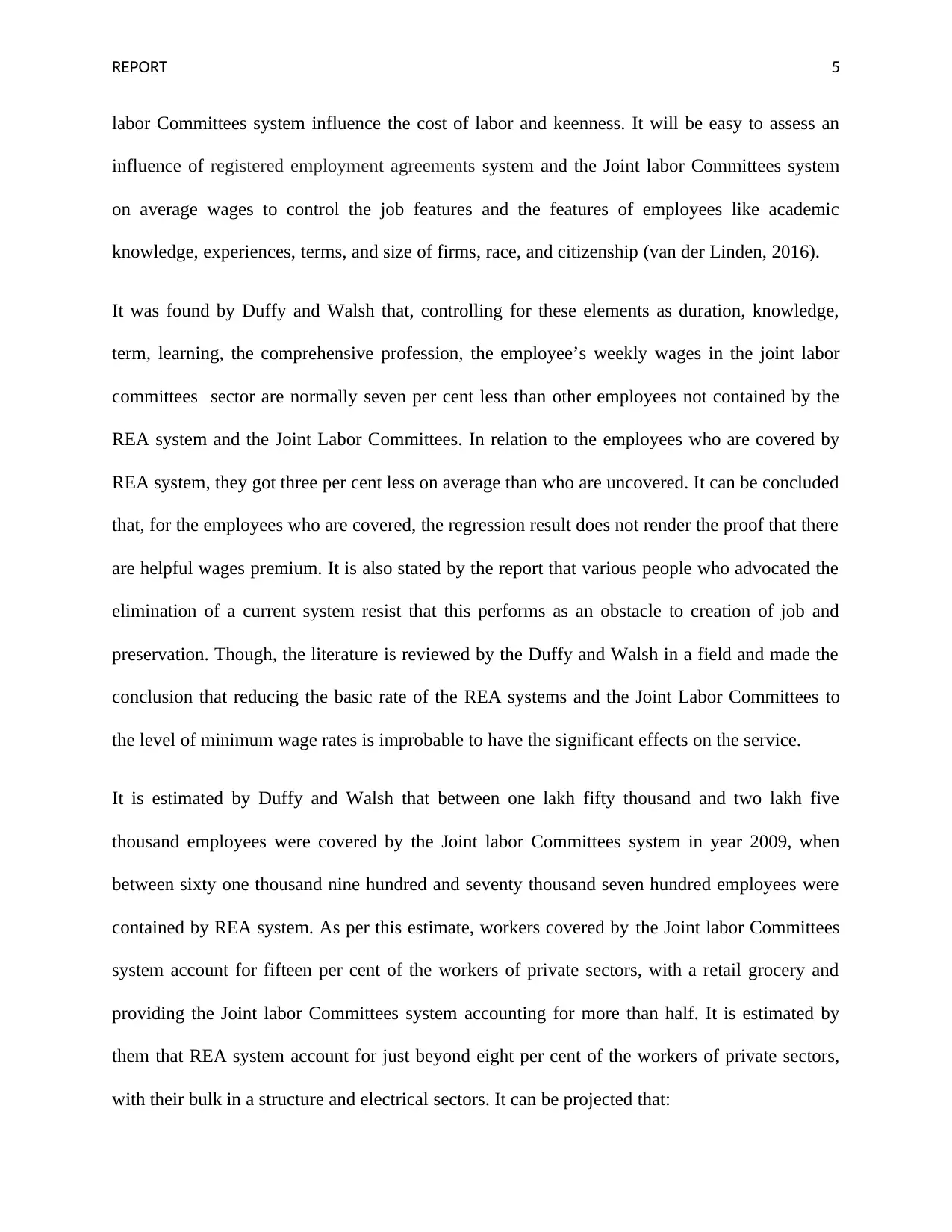
REPORT 5
labor Committees system influence the cost of labor and keenness. It will be easy to assess an
influence of registered employment agreements system and the Joint labor Committees system
on average wages to control the job features and the features of employees like academic
knowledge, experiences, terms, and size of firms, race, and citizenship (van der Linden, 2016).
It was found by Duffy and Walsh that, controlling for these elements as duration, knowledge,
term, learning, the comprehensive profession, the employee’s weekly wages in the joint labor
committees sector are normally seven per cent less than other employees not contained by the
REA system and the Joint Labor Committees. In relation to the employees who are covered by
REA system, they got three per cent less on average than who are uncovered. It can be concluded
that, for the employees who are covered, the regression result does not render the proof that there
are helpful wages premium. It is also stated by the report that various people who advocated the
elimination of a current system resist that this performs as an obstacle to creation of job and
preservation. Though, the literature is reviewed by the Duffy and Walsh in a field and made the
conclusion that reducing the basic rate of the REA systems and the Joint Labor Committees to
the level of minimum wage rates is improbable to have the significant effects on the service.
It is estimated by Duffy and Walsh that between one lakh fifty thousand and two lakh five
thousand employees were covered by the Joint labor Committees system in year 2009, when
between sixty one thousand nine hundred and seventy thousand seven hundred employees were
contained by REA system. As per this estimate, workers covered by the Joint labor Committees
system account for fifteen per cent of the workers of private sectors, with a retail grocery and
providing the Joint labor Committees system accounting for more than half. It is estimated by
them that REA system account for just beyond eight per cent of the workers of private sectors,
with their bulk in a structure and electrical sectors. It can be projected that:
labor Committees system influence the cost of labor and keenness. It will be easy to assess an
influence of registered employment agreements system and the Joint labor Committees system
on average wages to control the job features and the features of employees like academic
knowledge, experiences, terms, and size of firms, race, and citizenship (van der Linden, 2016).
It was found by Duffy and Walsh that, controlling for these elements as duration, knowledge,
term, learning, the comprehensive profession, the employee’s weekly wages in the joint labor
committees sector are normally seven per cent less than other employees not contained by the
REA system and the Joint Labor Committees. In relation to the employees who are covered by
REA system, they got three per cent less on average than who are uncovered. It can be concluded
that, for the employees who are covered, the regression result does not render the proof that there
are helpful wages premium. It is also stated by the report that various people who advocated the
elimination of a current system resist that this performs as an obstacle to creation of job and
preservation. Though, the literature is reviewed by the Duffy and Walsh in a field and made the
conclusion that reducing the basic rate of the REA systems and the Joint Labor Committees to
the level of minimum wage rates is improbable to have the significant effects on the service.
It is estimated by Duffy and Walsh that between one lakh fifty thousand and two lakh five
thousand employees were covered by the Joint labor Committees system in year 2009, when
between sixty one thousand nine hundred and seventy thousand seven hundred employees were
contained by REA system. As per this estimate, workers covered by the Joint labor Committees
system account for fifteen per cent of the workers of private sectors, with a retail grocery and
providing the Joint labor Committees system accounting for more than half. It is estimated by
them that REA system account for just beyond eight per cent of the workers of private sectors,
with their bulk in a structure and electrical sectors. It can be projected that:
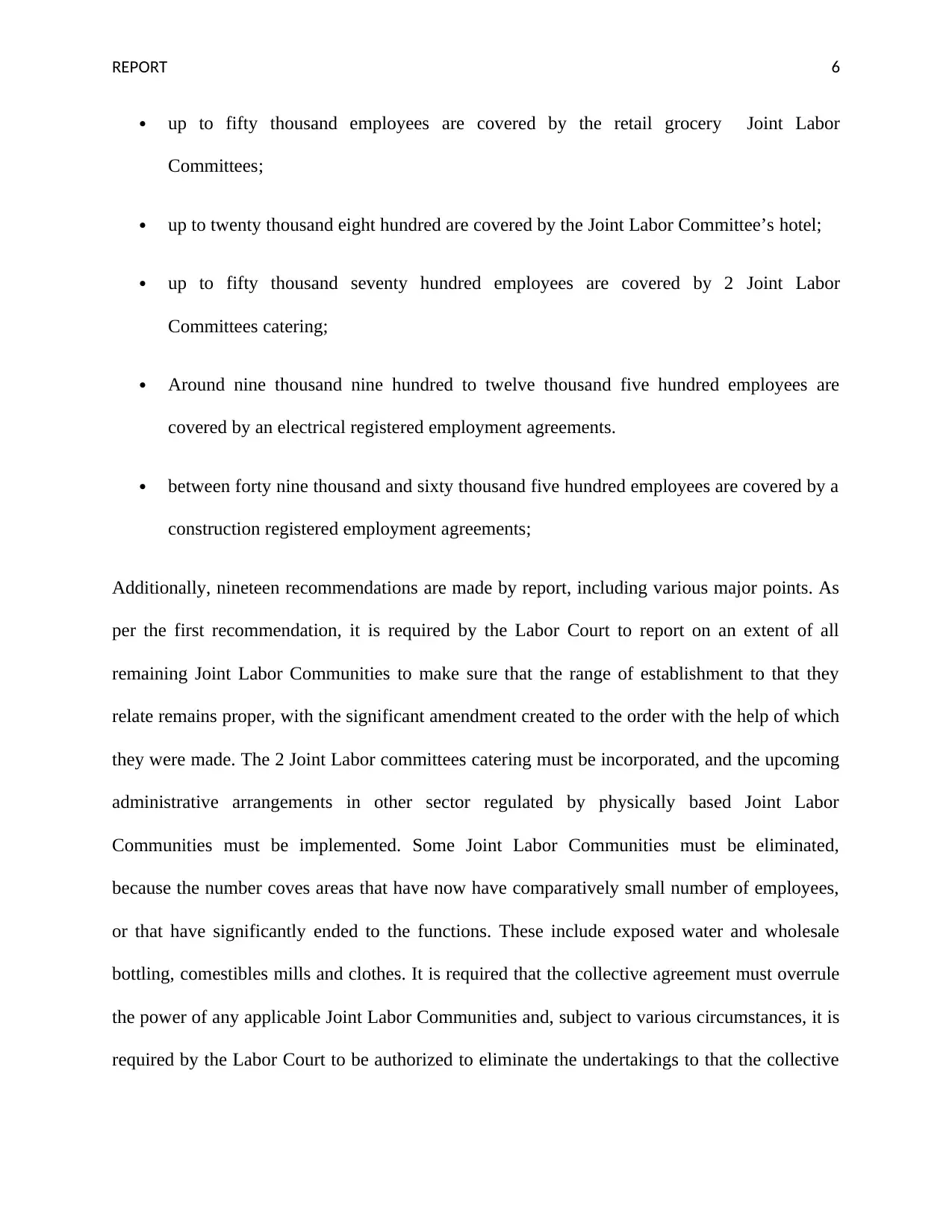
REPORT 6
up to fifty thousand employees are covered by the retail grocery Joint Labor
Committees;
up to twenty thousand eight hundred are covered by the Joint Labor Committee’s hotel;
up to fifty thousand seventy hundred employees are covered by 2 Joint Labor
Committees catering;
Around nine thousand nine hundred to twelve thousand five hundred employees are
covered by an electrical registered employment agreements.
between forty nine thousand and sixty thousand five hundred employees are covered by a
construction registered employment agreements;
Additionally, nineteen recommendations are made by report, including various major points. As
per the first recommendation, it is required by the Labor Court to report on an extent of all
remaining Joint Labor Communities to make sure that the range of establishment to that they
relate remains proper, with the significant amendment created to the order with the help of which
they were made. The 2 Joint Labor committees catering must be incorporated, and the upcoming
administrative arrangements in other sector regulated by physically based Joint Labor
Communities must be implemented. Some Joint Labor Communities must be eliminated,
because the number coves areas that have now have comparatively small number of employees,
or that have significantly ended to the functions. These include exposed water and wholesale
bottling, comestibles mills and clothes. It is required that the collective agreement must overrule
the power of any applicable Joint Labor Communities and, subject to various circumstances, it is
required by the Labor Court to be authorized to eliminate the undertakings to that the collective
up to fifty thousand employees are covered by the retail grocery Joint Labor
Committees;
up to twenty thousand eight hundred are covered by the Joint Labor Committee’s hotel;
up to fifty thousand seventy hundred employees are covered by 2 Joint Labor
Committees catering;
Around nine thousand nine hundred to twelve thousand five hundred employees are
covered by an electrical registered employment agreements.
between forty nine thousand and sixty thousand five hundred employees are covered by a
construction registered employment agreements;
Additionally, nineteen recommendations are made by report, including various major points. As
per the first recommendation, it is required by the Labor Court to report on an extent of all
remaining Joint Labor Communities to make sure that the range of establishment to that they
relate remains proper, with the significant amendment created to the order with the help of which
they were made. The 2 Joint Labor committees catering must be incorporated, and the upcoming
administrative arrangements in other sector regulated by physically based Joint Labor
Communities must be implemented. Some Joint Labor Communities must be eliminated,
because the number coves areas that have now have comparatively small number of employees,
or that have significantly ended to the functions. These include exposed water and wholesale
bottling, comestibles mills and clothes. It is required that the collective agreement must overrule
the power of any applicable Joint Labor Communities and, subject to various circumstances, it is
required by the Labor Court to be authorized to eliminate the undertakings to that the collective
⊘ This is a preview!⊘
Do you want full access?
Subscribe today to unlock all pages.

Trusted by 1+ million students worldwide

REPORT 7
agreement implements from the area of Joint Labor Communities (Kerrissey, J. and Schuhrke,
2016).
Likewise, the mechanism to fix pay must be determined by legislature to set out the doctrines in
line with that offered in the Industrial Relations (Amendment) Bill 2009, and that the Labor
Court and Joint Labor Communities should consider while deciding the term of registered
employment agreements. In the lack of central agreements, it is possible that the labor court can
render all-purpose directions to the Joint Labor Communities on proper pay rises. In an occasion
of central wage agreement being decided or settled in the upcoming period, the agreement’s
parties must create the particular provisions for the manner rises are addressed in a case of the
Joint Labor Communities regarding rises in the general minimum wage. In the case where the
general minimum wage is accustomed downwards, the Joint Labor Communities must have to
consider, within the prescribed period, also making the revision of the rate specified by the
Employment Regulation Orders to the extent that possible, regulations on over period. It is
required that the Sunday premium must be identical (Humphrey, 2017).
Trade union movement in Ireland
The trade union is the institution established by the employees to secure the member’s interest.
Conventionally, it is appears as the proper sources of counting posers of workers. The
fundamental strong point lies in the capability to manage for better improvement. The main
function of Trade Union is to secure the rights of members of Trade Union. It also negotiates the
salaries and wages. It also negotiates the working condition in the proper way (Loyal and
Quilley, 2016). The Trade Union represents its members at payment agreements by the collective
agreement implements from the area of Joint Labor Communities (Kerrissey, J. and Schuhrke,
2016).
Likewise, the mechanism to fix pay must be determined by legislature to set out the doctrines in
line with that offered in the Industrial Relations (Amendment) Bill 2009, and that the Labor
Court and Joint Labor Communities should consider while deciding the term of registered
employment agreements. In the lack of central agreements, it is possible that the labor court can
render all-purpose directions to the Joint Labor Communities on proper pay rises. In an occasion
of central wage agreement being decided or settled in the upcoming period, the agreement’s
parties must create the particular provisions for the manner rises are addressed in a case of the
Joint Labor Communities regarding rises in the general minimum wage. In the case where the
general minimum wage is accustomed downwards, the Joint Labor Communities must have to
consider, within the prescribed period, also making the revision of the rate specified by the
Employment Regulation Orders to the extent that possible, regulations on over period. It is
required that the Sunday premium must be identical (Humphrey, 2017).
Trade union movement in Ireland
The trade union is the institution established by the employees to secure the member’s interest.
Conventionally, it is appears as the proper sources of counting posers of workers. The
fundamental strong point lies in the capability to manage for better improvement. The main
function of Trade Union is to secure the rights of members of Trade Union. It also negotiates the
salaries and wages. It also negotiates the working condition in the proper way (Loyal and
Quilley, 2016). The Trade Union represents its members at payment agreements by the collective
Paraphrase This Document
Need a fresh take? Get an instant paraphrase of this document with our AI Paraphraser
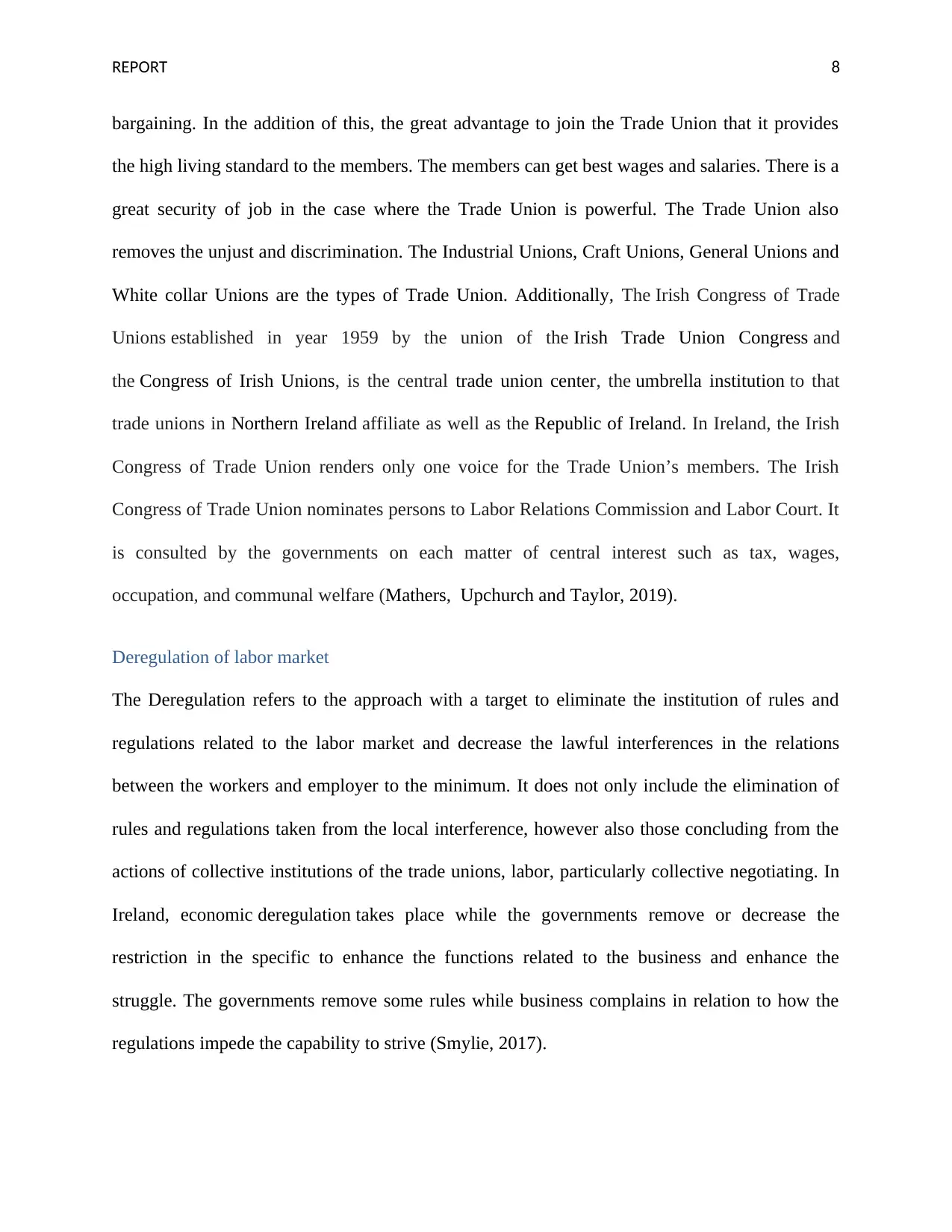
REPORT 8
bargaining. In the addition of this, the great advantage to join the Trade Union that it provides
the high living standard to the members. The members can get best wages and salaries. There is a
great security of job in the case where the Trade Union is powerful. The Trade Union also
removes the unjust and discrimination. The Industrial Unions, Craft Unions, General Unions and
White collar Unions are the types of Trade Union. Additionally, The Irish Congress of Trade
Unions established in year 1959 by the union of the Irish Trade Union Congress and
the Congress of Irish Unions, is the central trade union center, the umbrella institution to that
trade unions in Northern Ireland affiliate as well as the Republic of Ireland. In Ireland, the Irish
Congress of Trade Union renders only one voice for the Trade Union’s members. The Irish
Congress of Trade Union nominates persons to Labor Relations Commission and Labor Court. It
is consulted by the governments on each matter of central interest such as tax, wages,
occupation, and communal welfare (Mathers, Upchurch and Taylor, 2019).
Deregulation of labor market
The Deregulation refers to the approach with a target to eliminate the institution of rules and
regulations related to the labor market and decrease the lawful interferences in the relations
between the workers and employer to the minimum. It does not only include the elimination of
rules and regulations taken from the local interference, however also those concluding from the
actions of collective institutions of the trade unions, labor, particularly collective negotiating. In
Ireland, economic deregulation takes place while the governments remove or decrease the
restriction in the specific to enhance the functions related to the business and enhance the
struggle. The governments remove some rules while business complains in relation to how the
regulations impede the capability to strive (Smylie, 2017).
bargaining. In the addition of this, the great advantage to join the Trade Union that it provides
the high living standard to the members. The members can get best wages and salaries. There is a
great security of job in the case where the Trade Union is powerful. The Trade Union also
removes the unjust and discrimination. The Industrial Unions, Craft Unions, General Unions and
White collar Unions are the types of Trade Union. Additionally, The Irish Congress of Trade
Unions established in year 1959 by the union of the Irish Trade Union Congress and
the Congress of Irish Unions, is the central trade union center, the umbrella institution to that
trade unions in Northern Ireland affiliate as well as the Republic of Ireland. In Ireland, the Irish
Congress of Trade Union renders only one voice for the Trade Union’s members. The Irish
Congress of Trade Union nominates persons to Labor Relations Commission and Labor Court. It
is consulted by the governments on each matter of central interest such as tax, wages,
occupation, and communal welfare (Mathers, Upchurch and Taylor, 2019).
Deregulation of labor market
The Deregulation refers to the approach with a target to eliminate the institution of rules and
regulations related to the labor market and decrease the lawful interferences in the relations
between the workers and employer to the minimum. It does not only include the elimination of
rules and regulations taken from the local interference, however also those concluding from the
actions of collective institutions of the trade unions, labor, particularly collective negotiating. In
Ireland, economic deregulation takes place while the governments remove or decrease the
restriction in the specific to enhance the functions related to the business and enhance the
struggle. The governments remove some rules while business complains in relation to how the
regulations impede the capability to strive (Smylie, 2017).
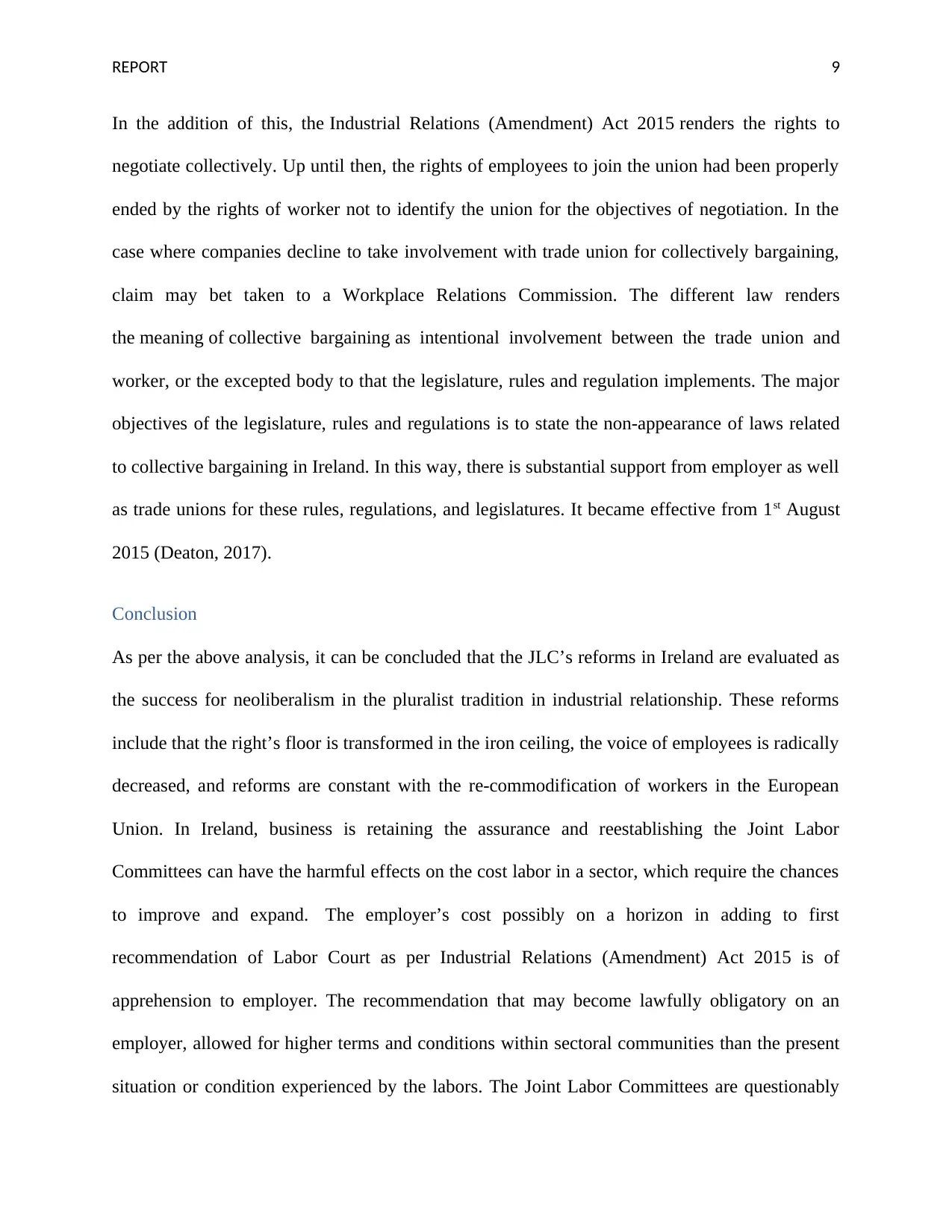
REPORT 9
In the addition of this, the Industrial Relations (Amendment) Act 2015 renders the rights to
negotiate collectively. Up until then, the rights of employees to join the union had been properly
ended by the rights of worker not to identify the union for the objectives of negotiation. In the
case where companies decline to take involvement with trade union for collectively bargaining,
claim may bet taken to a Workplace Relations Commission. The different law renders
the meaning of collective bargaining as intentional involvement between the trade union and
worker, or the excepted body to that the legislature, rules and regulation implements. The major
objectives of the legislature, rules and regulations is to state the non-appearance of laws related
to collective bargaining in Ireland. In this way, there is substantial support from employer as well
as trade unions for these rules, regulations, and legislatures. It became effective from 1st August
2015 (Deaton, 2017).
Conclusion
As per the above analysis, it can be concluded that the JLC’s reforms in Ireland are evaluated as
the success for neoliberalism in the pluralist tradition in industrial relationship. These reforms
include that the right’s floor is transformed in the iron ceiling, the voice of employees is radically
decreased, and reforms are constant with the re‐commodification of workers in the European
Union. In Ireland, business is retaining the assurance and reestablishing the Joint Labor
Committees can have the harmful effects on the cost labor in a sector, which require the chances
to improve and expand. The employer’s cost possibly on a horizon in adding to first
recommendation of Labor Court as per Industrial Relations (Amendment) Act 2015 is of
apprehension to employer. The recommendation that may become lawfully obligatory on an
employer, allowed for higher terms and conditions within sectoral communities than the present
situation or condition experienced by the labors. The Joint Labor Committees are questionably
In the addition of this, the Industrial Relations (Amendment) Act 2015 renders the rights to
negotiate collectively. Up until then, the rights of employees to join the union had been properly
ended by the rights of worker not to identify the union for the objectives of negotiation. In the
case where companies decline to take involvement with trade union for collectively bargaining,
claim may bet taken to a Workplace Relations Commission. The different law renders
the meaning of collective bargaining as intentional involvement between the trade union and
worker, or the excepted body to that the legislature, rules and regulation implements. The major
objectives of the legislature, rules and regulations is to state the non-appearance of laws related
to collective bargaining in Ireland. In this way, there is substantial support from employer as well
as trade unions for these rules, regulations, and legislatures. It became effective from 1st August
2015 (Deaton, 2017).
Conclusion
As per the above analysis, it can be concluded that the JLC’s reforms in Ireland are evaluated as
the success for neoliberalism in the pluralist tradition in industrial relationship. These reforms
include that the right’s floor is transformed in the iron ceiling, the voice of employees is radically
decreased, and reforms are constant with the re‐commodification of workers in the European
Union. In Ireland, business is retaining the assurance and reestablishing the Joint Labor
Committees can have the harmful effects on the cost labor in a sector, which require the chances
to improve and expand. The employer’s cost possibly on a horizon in adding to first
recommendation of Labor Court as per Industrial Relations (Amendment) Act 2015 is of
apprehension to employer. The recommendation that may become lawfully obligatory on an
employer, allowed for higher terms and conditions within sectoral communities than the present
situation or condition experienced by the labors. The Joint Labor Committees are questionably
⊘ This is a preview!⊘
Do you want full access?
Subscribe today to unlock all pages.

Trusted by 1+ million students worldwide
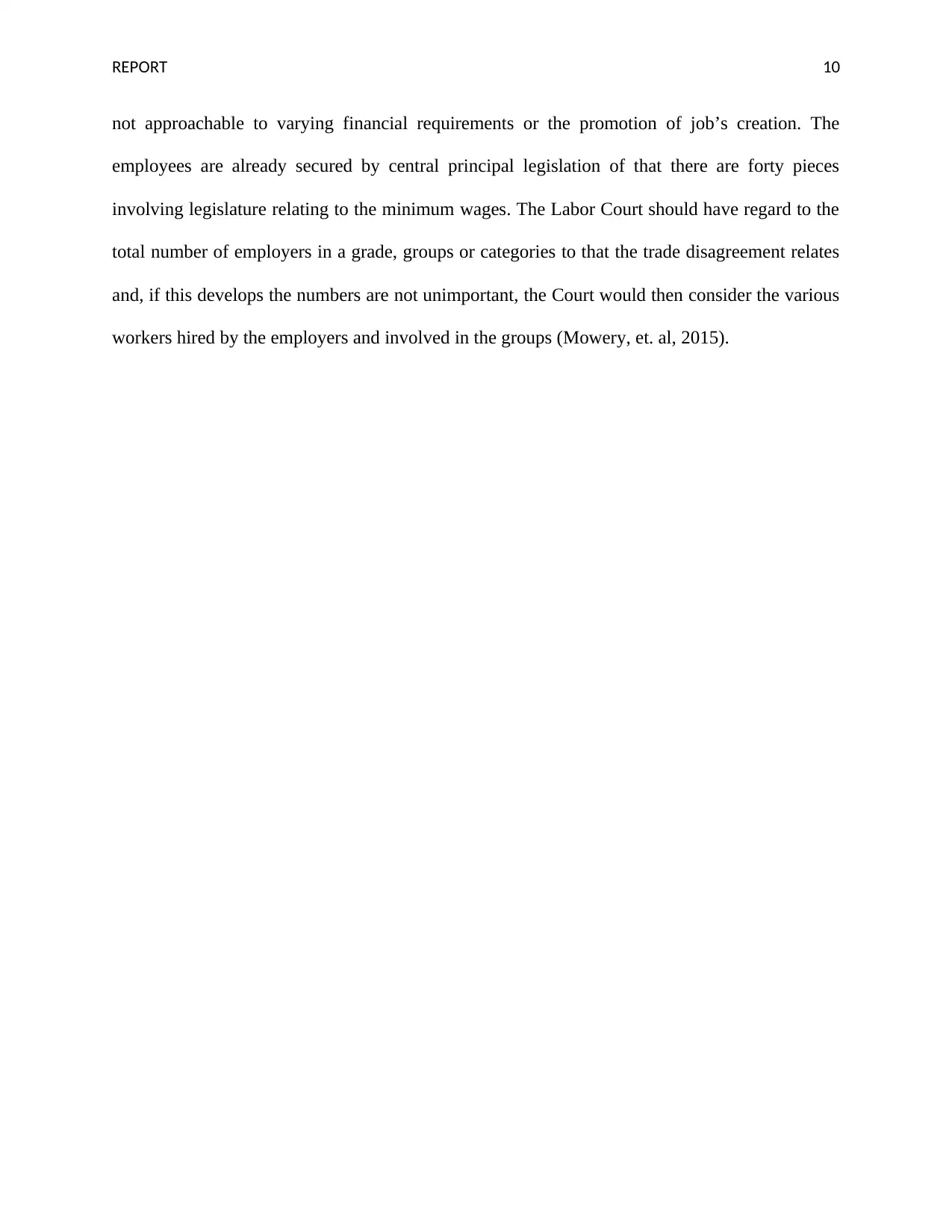
REPORT 10
not approachable to varying financial requirements or the promotion of job’s creation. The
employees are already secured by central principal legislation of that there are forty pieces
involving legislature relating to the minimum wages. The Labor Court should have regard to the
total number of employers in a grade, groups or categories to that the trade disagreement relates
and, if this develops the numbers are not unimportant, the Court would then consider the various
workers hired by the employers and involved in the groups (Mowery, et. al, 2015).
not approachable to varying financial requirements or the promotion of job’s creation. The
employees are already secured by central principal legislation of that there are forty pieces
involving legislature relating to the minimum wages. The Labor Court should have regard to the
total number of employers in a grade, groups or categories to that the trade disagreement relates
and, if this develops the numbers are not unimportant, the Court would then consider the various
workers hired by the employers and involved in the groups (Mowery, et. al, 2015).
Paraphrase This Document
Need a fresh take? Get an instant paraphrase of this document with our AI Paraphraser
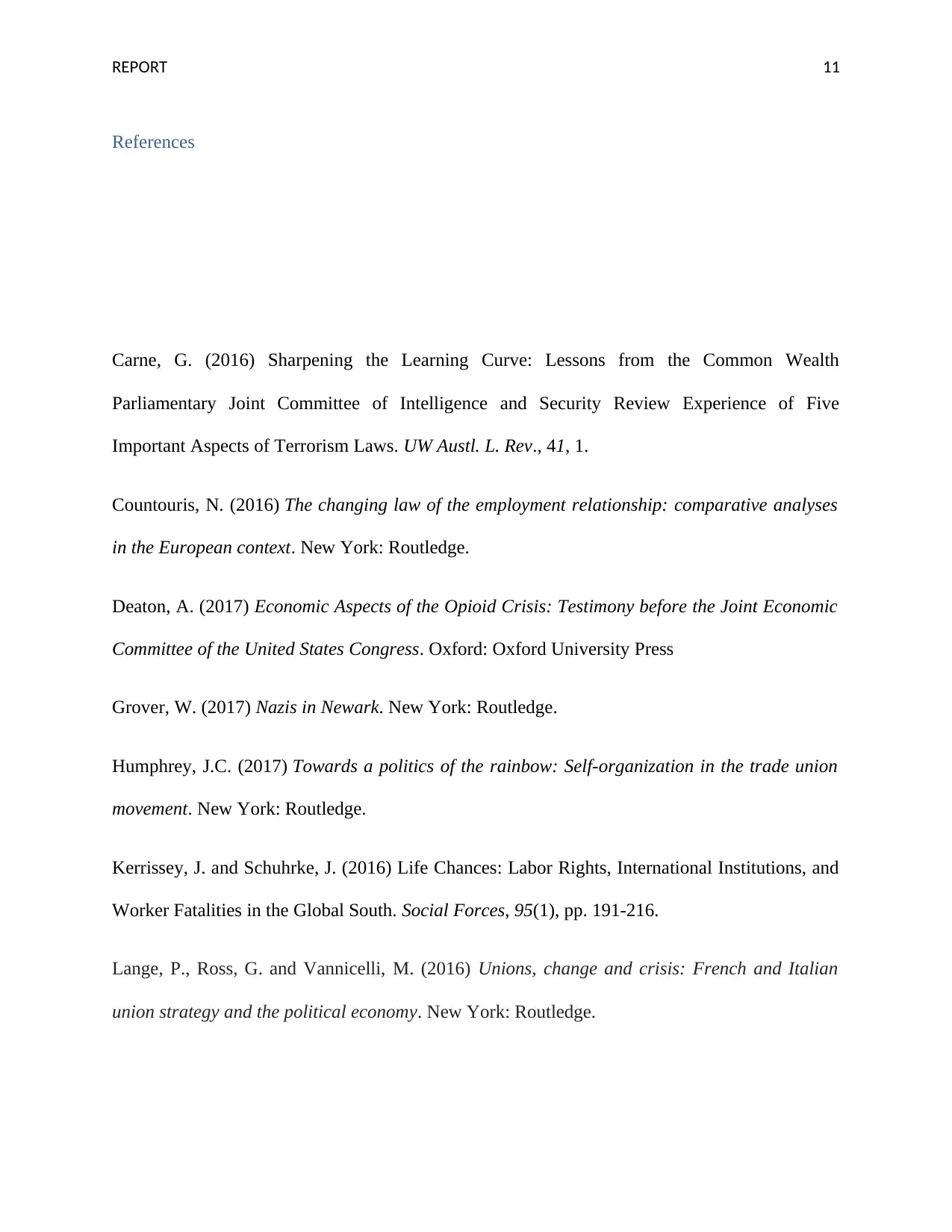
REPORT 11
References
Carne, G. (2016) Sharpening the Learning Curve: Lessons from the Common Wealth
Parliamentary Joint Committee of Intelligence and Security Review Experience of Five
Important Aspects of Terrorism Laws. UW Austl. L. Rev., 41, 1.
Countouris, N. (2016) The changing law of the employment relationship: comparative analyses
in the European context. New York: Routledge.
Deaton, A. (2017) Economic Aspects of the Opioid Crisis: Testimony before the Joint Economic
Committee of the United States Congress. Oxford: Oxford University Press
Grover, W. (2017) Nazis in Newark. New York: Routledge.
Humphrey, J.C. (2017) Towards a politics of the rainbow: Self-organization in the trade union
movement. New York: Routledge.
Kerrissey, J. and Schuhrke, J. (2016) Life Chances: Labor Rights, International Institutions, and
Worker Fatalities in the Global South. Social Forces, 95(1), pp. 191-216.
Lange, P., Ross, G. and Vannicelli, M. (2016) Unions, change and crisis: French and Italian
union strategy and the political economy. New York: Routledge.
References
Carne, G. (2016) Sharpening the Learning Curve: Lessons from the Common Wealth
Parliamentary Joint Committee of Intelligence and Security Review Experience of Five
Important Aspects of Terrorism Laws. UW Austl. L. Rev., 41, 1.
Countouris, N. (2016) The changing law of the employment relationship: comparative analyses
in the European context. New York: Routledge.
Deaton, A. (2017) Economic Aspects of the Opioid Crisis: Testimony before the Joint Economic
Committee of the United States Congress. Oxford: Oxford University Press
Grover, W. (2017) Nazis in Newark. New York: Routledge.
Humphrey, J.C. (2017) Towards a politics of the rainbow: Self-organization in the trade union
movement. New York: Routledge.
Kerrissey, J. and Schuhrke, J. (2016) Life Chances: Labor Rights, International Institutions, and
Worker Fatalities in the Global South. Social Forces, 95(1), pp. 191-216.
Lange, P., Ross, G. and Vannicelli, M. (2016) Unions, change and crisis: French and Italian
union strategy and the political economy. New York: Routledge.
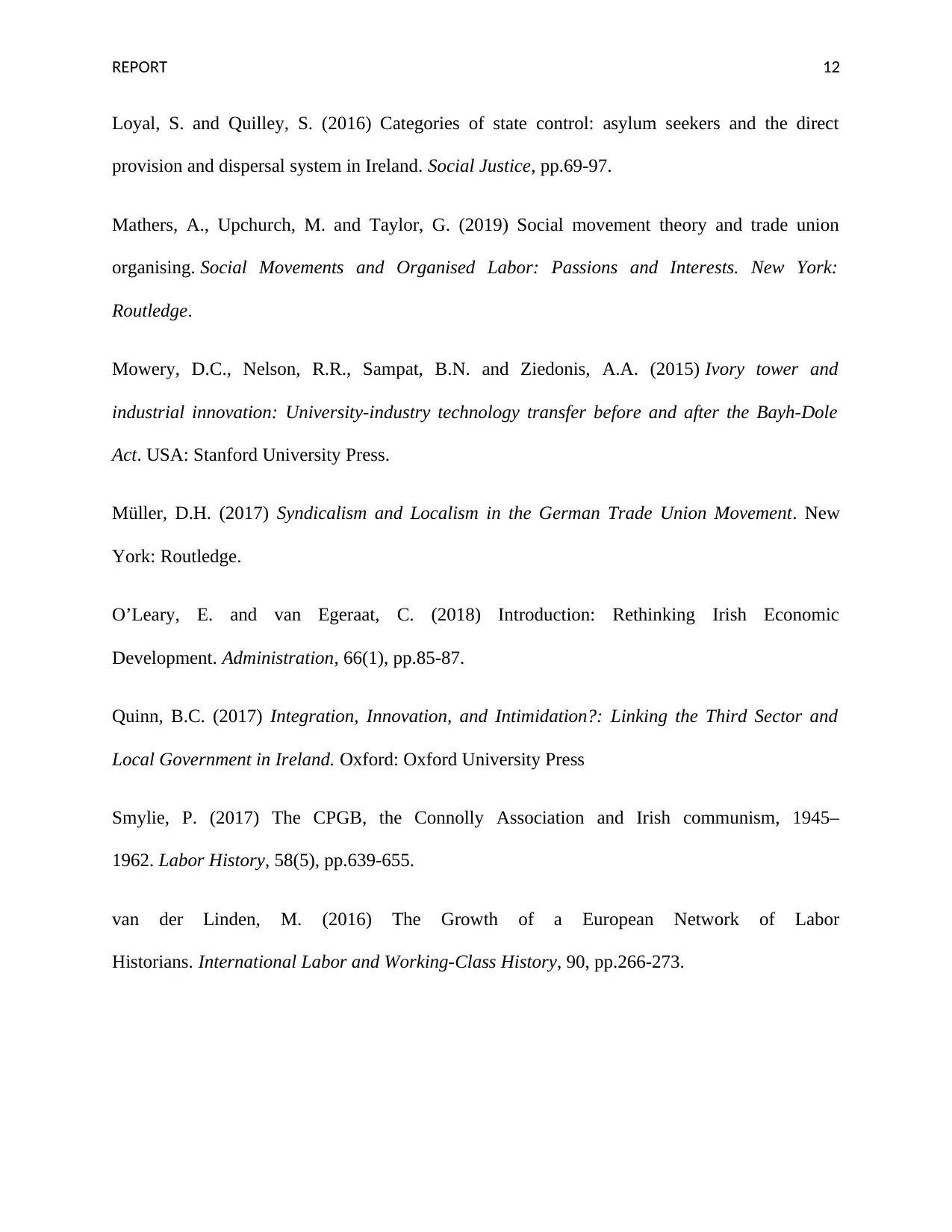
REPORT 12
Loyal, S. and Quilley, S. (2016) Categories of state control: asylum seekers and the direct
provision and dispersal system in Ireland. Social Justice, pp.69-97.
Mathers, A., Upchurch, M. and Taylor, G. (2019) Social movement theory and trade union
organising. Social Movements and Organised Labor: Passions and Interests. New York:
Routledge.
Mowery, D.C., Nelson, R.R., Sampat, B.N. and Ziedonis, A.A. (2015) Ivory tower and
industrial innovation: University-industry technology transfer before and after the Bayh-Dole
Act. USA: Stanford University Press.
Müller, D.H. (2017) Syndicalism and Localism in the German Trade Union Movement. New
York: Routledge.
O’Leary, E. and van Egeraat, C. (2018) Introduction: Rethinking Irish Economic
Development. Administration, 66(1), pp.85-87.
Quinn, B.C. (2017) Integration, Innovation, and Intimidation?: Linking the Third Sector and
Local Government in Ireland. Oxford: Oxford University Press
Smylie, P. (2017) The CPGB, the Connolly Association and Irish communism, 1945–
1962. Labor History, 58(5), pp.639-655.
van der Linden, M. (2016) The Growth of a European Network of Labor
Historians. International Labor and Working-Class History, 90, pp.266-273.
Loyal, S. and Quilley, S. (2016) Categories of state control: asylum seekers and the direct
provision and dispersal system in Ireland. Social Justice, pp.69-97.
Mathers, A., Upchurch, M. and Taylor, G. (2019) Social movement theory and trade union
organising. Social Movements and Organised Labor: Passions and Interests. New York:
Routledge.
Mowery, D.C., Nelson, R.R., Sampat, B.N. and Ziedonis, A.A. (2015) Ivory tower and
industrial innovation: University-industry technology transfer before and after the Bayh-Dole
Act. USA: Stanford University Press.
Müller, D.H. (2017) Syndicalism and Localism in the German Trade Union Movement. New
York: Routledge.
O’Leary, E. and van Egeraat, C. (2018) Introduction: Rethinking Irish Economic
Development. Administration, 66(1), pp.85-87.
Quinn, B.C. (2017) Integration, Innovation, and Intimidation?: Linking the Third Sector and
Local Government in Ireland. Oxford: Oxford University Press
Smylie, P. (2017) The CPGB, the Connolly Association and Irish communism, 1945–
1962. Labor History, 58(5), pp.639-655.
van der Linden, M. (2016) The Growth of a European Network of Labor
Historians. International Labor and Working-Class History, 90, pp.266-273.
⊘ This is a preview!⊘
Do you want full access?
Subscribe today to unlock all pages.

Trusted by 1+ million students worldwide
1 out of 12
Your All-in-One AI-Powered Toolkit for Academic Success.
+13062052269
info@desklib.com
Available 24*7 on WhatsApp / Email
![[object Object]](/_next/static/media/star-bottom.7253800d.svg)
Unlock your academic potential
Copyright © 2020–2025 A2Z Services. All Rights Reserved. Developed and managed by ZUCOL.


